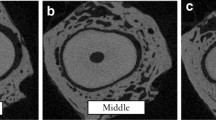Abstract.
Material and Methods: The aim of this study was to determine the elasticity parameters of the human periodontal ligament by measuring three-dimensionally the initial buccolingual tooth displacements of eight singl-rooted teeth in human jaw specimens, using a noninvasive method. Subsequently the specimens were used to develop finite element models presenting the same individual geometry as the respective autopsy material. These models formed the basis for computerized movement simulations, whose characteristic was brought into line with the experimentally registered movements by adapting the elasticity parameters of the periodontal ligament. Using the individual elasticity parameters determined in this way, with which the displacement of the ocmputer models could be realistically calculated, the centers of resistance of the examined teeth were determined by simulating the effects of different force systems.
Results: The nonlinear character of the initial tooth movement could be effectively simulated by using a bilinear parameter set for the elasticity of the periodontal ligament and by determining a critical expansion value for the transition from the validity range of the first Young's modulus to the second. The mean Young's modulus of the first phase of movement was 0.05 MPa, that of the second phase 0.28 MPa, and the critical expansion 7.5% (Poisson's ratio μ = 0.3). The centers of resistance of single-rooted teeth were found to be at approximately 42% of the alveolar height from the alveolar crest to the apex, irrespective of root length and direction of loading.
Conclusion: The elasticity parameters were found to be on a similar scale to those determined in previous studies on multi-rooted pig teeth.
Zusammenfassung.
Material und Methode: Zur Bestimmung der Elastizitätseigenschaften von menschlischem Parodontalligament wurde eine horizontale Initialbewegung einwurzeliger Zähne an acht Kieferpräparaten in einem nicht invasiven Registrierverfahren dreidimensional gemessen. Anschließend wurden Finite-Elemente-Modelle von allen untersuchten Präparaten entwickelt, die in ihrer Geometrie den Originalen entsprachen. Diese Modelle waren die Grundlage für computerberechnete Bewegungssimulationen, deren Charakteristik durch Anpassung der Elastizitätseigenschaften des Parodontalligaments mit den experimentell gemessenen Bewegungsgrößen zur Deckung gebracht wurde. Unter Verwendung der so ermittelten individuellen Elastizitätsparameter, mit denen die Auslenkungen der Computermodelle realistisch berechnet werden konnten, wurden durch Simulation der Wirkungen unterschiedlicher Kraftsysteme die Widerstandszentren der untersuchten Zähne bestimmt.
Ergebnisse: Die Nichtlinearität der initialen Zahnbewegung konnte durch Verwendung eines bilinearen Parametersatzes für die Elastizität des Parodontalligaments und die Bestimmung eines Grenzdehnungswertes für den Übergang vom Geltungsbereich des ersten E-Moduls zum zweiten gut simuliert werden. Der E-Modul der ersten Phase der Bewegung betrug im Mittel 0,05 MPa, der E-Modul der zweiten Phase 0,28 MPa und die Grenzdehnung 7,5% (Poissonzahl 0,3). Die Widerstandszentren einwurzeliger Zähne lagen unabhängig von der Wurzellänge und der Belastungsrichtung bei etwa 42% der Alveolenhöhe in koronal-apikaler Richtung.
Schlussfolgerung: Es konnte gezeigt werden, dass die ermittelten Elastizitätsparameter in ihrer Größenordnung denen für mehrwurzelige Schweinezähne, die in Voruntersuchungen bestimmt wurden, entsprechen.
Similar content being viewed by others
Author information
Authors and Affiliations
Additional information
Received: December 12, 2000; accepted: November 16, 2001
Rights and permissions
About this article
Cite this article
Poppe, M., Bourauel, C. & Jäger, A. Determination of the Elasticity Parameters of the Human Periodontal Ligament and the Location of the Center of Resistance of Single-rooted Teeth A Study of Autopsy Specimens and Their Conversion into Finite Element Models. Journal of Orofacial Orthopedics / Fortschritte der Kieferorthopädie 63, 358–370 (2002). https://doi.org/10.1007/s00056-002-0067-8
Issue Date:
DOI: https://doi.org/10.1007/s00056-002-0067-8




